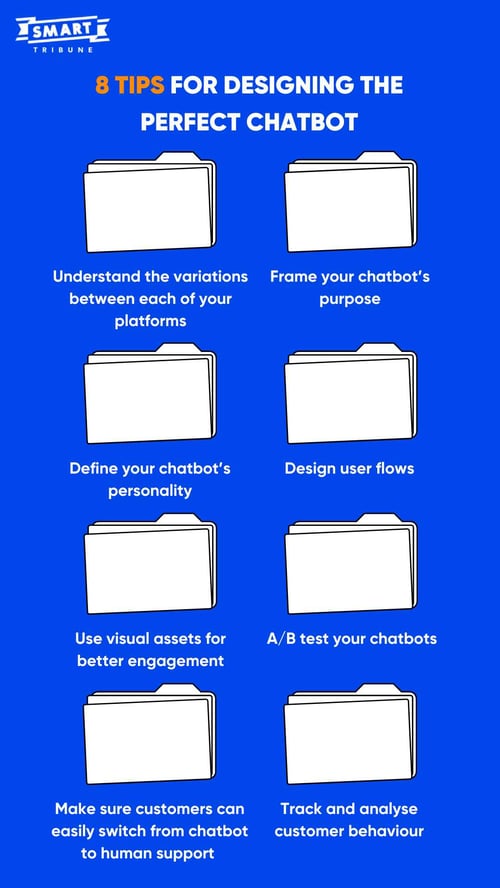
On OCTOBER 18, 2022
8 Tips for Designing the Perfect Chatbot for Your Business
If you’re a marketer in 2022, you already know just how powerful chatbots can be. These automated tools play an increasingly pivotal role in customer service. They automatically answer a wide range of consumer queries in real time, lightening the load on customer service teams while providing a stellar customer experience (CX).
Of course, not all chatbots are the same—and this largely comes down to their design. Companies must invest the necessary time and energy to create chatbots that reflect their brand, injecting the appropriate personality, voice, and mannerisms. This requires leveraging sophisticated AI technology, the latest CX trends, and more.
Sound complicated? Don’t worry—it’s fairly simple once you know how. By following our 8 tips for designing the perfect chatbot for your business, you can create high-performing chatbots that successfully engage customers at scale. Here’s how.
Table Of Contents:
- Understand the variations between each of your platforms
- Frame your chatbot’s purpose
- Define your chatbot’s personality
- Design user flows
- Use visual assets for better engagement
- A/B test your chatbots
- Make sure customers can easily switch from chatbot to human support
- Track and analyse customer behaviour
1. Understand the variations between each of your platforms
Chatbots shouldn’t necessarily be one-size-fits-all. Each platform has its own users, trends, advantages, and disadvantages. By ensuring you understand the variations between each of your platforms, you can tailor your chatbots accordingly.
Imagine you’re creating chatbots for Facebook Messenger, Twitter, and WhatsApp.
First, you need to consider the platform’s limitations. Facebook Messenger and WhatsApp chatbots can provide lengthy responses, but Twitter’s character limit means your chatbot needs to be direct and to the point. However, this tone might not please some customers—so you should consider how you can use soft language while still providing succinct responses to customer queries.
You should also consider each platform’s user demographics. Your Brazilian users might flock to WhatsApp, considering 98.9% of the country’s mobile users have the app. In Denmark, just 22% of the country use WhatsApp—but Facebook Messenger is their favourite app.
So, what does this mean for you?
In this case, consider giving your WhatsApp chatbot a more playful personality than your Facebook Messenger chatbot. Brazilians are known for their expressive, passionate communication style, whereas Danish people can often be more subdued.
2. Frame your chatbot’s purpose
Ensure you know your chatbot’s purpose before you begin the design process. Having a solid purpose in mind will guide your app design efforts, making it more likely that the chatbot will successfully deliver your desired outcomes. For example, a chatbot you created to collect user feedback should differ from one you created to resolve customers’ queries.
Businesses are becoming increasingly creative with how they use chatbots. Nowadays, you can create chatbots to achieve a wide range of goals—we explore these in more detail below.
Lead generation
Chatbots are far more than simply a customer service tool. For example, they can also help companies increase sales by using a conversational approach to identify what consumers need, offer up relevant, targeted suggestions, and highlight if your company has any special discounts or promotions that you think they might enjoy.
Read more: Top 9 Practices of Lead Generation Chatbot That Hit The Mark
Promoting new services/brand awareness
In addition to driving sales, chatbots can also connect with your customers to let them know of any new services you have just rolled out, or to give them interesting company updates that they might enjoy. For example, imagine you’re a market research company who has recently established a consultancy arm. You might use website chatbots to alert visitors to this new side of the business and to encourage them to find out more by heading to your ‘Consultancy’ page.

Answering FAQ questions
Companies most commonly use chatbots to resolve FAQ-type customer queries. Customer service agents have better things to deal with than answering routine questions repeatedly. By implementing chatbots, you can resolve customer queries at scale, automatically, without requiring your customer service team’s help.
Collecting survey feedback
For companies to provide a great CX, they must first know what their customers think, want, and need. This is where surveys come in. You can program your chatbot to get in touch with website visitors and ask them to complete a quick survey, collecting key feedback to fuel CX improvements going forward.
Read more: The best customer satisfaction survey examples.
Upsell
Chatbots acquire a wealth of data about each prospect/customer. For example, this might include what they previously purchased, items they’ve added to the cart but have not yet bought, or which marketing emails they have clicked on. Chatbots can use this information to identify what each customer wants from the company, and to upsell them on any relevant products that the customer might find useful.
3. Define your chatbot’s personality
One of the most common chatbot mistakes is not giving your chatbot a personality.
Once you’ve framed your chatbot’s objectives, you’ll need to choose the appropriate tone and personality to help you achieve these goals.
Your chatbot’s personality goes a long way to defining the CX that it offers. Therefore, it’s crucial to consider your brand’s tone of voice. For example, if you’re an insurance website, you might want to be friendly, sympathetic, and respectful. If you run a restaurant website, on the other hand, you can afford to be more excited, chatty, and confident.
However, if you’re a medical technology company, you might want to adopt a more serious time—having an overly excitable chatbot might negatively impact your credibility.
It’s worth also considering your different customer segments. For example, if your company works with both universities and students, then you can afford to be more approachable when speaking to students. They might appreciate an emoji here or there, whereas universities will probably prefer a more business-like tone.
As Jeremy Gaillard, CEO, Smart Tribune, comments: “Businesses often make a critical mistake when designing their chatbots—they focus on just one type of persona. While this works for some companies, most have several different customer segments. It therefore pays dividends to invest in creating chatbots that reflect these varying personalities, wants, and needs.”
4. Design user flows
Consider your user flows—in other words, the journey users take when engaging with a chatbot to resolve their queries. Keep conversations simple and to the point. Chatbots’ ultimate goal is to help users get from A to B. If they have a question, such as where their delivery is, the chatbot should answer it. Or, if the chatbot has been created to collect feedback, it should make it as easy as possible for users to provide their thoughts.
Chatbots shouldn’t take customers on long, winding journeys with no end goal in mind. Instead, customers should know exactly why they are communicating with the chatbot and always feel like they are successfully moving toward their desired outcome.
Add CTA buttons to direct users toward potential next steps. Consider using carousel chatbots to narrow down on exactly what each user wants, allowing them to select from a range of options. Better still, go to the next level by harnessing your user data (for example, their purchasing history) to provide personalised answers. Customers yearn for this type of experience—research shows that 68% of customers want support advisors to access their client profile and history in order to be better assisted.
Read more: Omnichannel Strategies in 2022

5. Use visual assets for better engagement
It’s important to remember that text-based communication isn’t the only way to interact with customers. As the saying goes, a picture tells 1,000 words. The younger generations are especially fond of using visual assets to communicate, including GIFs, emojis, or even memes.

Of course, not every company should use this tactic. Consider banks, for example. They should probably avoid using visual assets as customers might think they’re not taking their jobs seriously enough. Conversely, innovative startups targeted at a younger audience should definitely use visual assets within their chatbot operations. This will likely increase engagement and can boost the overall CX.
6. A/B test your chatbots
Designing the perfect chatbot requires plenty of trial and error—companies shouldn’t expect to get it right the first time they try.
In fact, if your company has never even used chatbots before, you’ll need to go through multiple testing stages before you settle on a design that works best for your audience. This is where A/B testing comes in.
A/B testing involves creating two versions of the same product (in this case, chatbots): version A and version B. Companies can then put these two chatbots to the test, identifying which ones work best for their needs—and for their customers.
Jeremy Gailard agrees: “A/B testing is a pivotal stage of the chatbot design process. Marketers will determine whether their assumptions are correct and quickly identify any issues with their current approach. This means that when they do roll out their chatbot solutions, they already know they’ll deliver the intended results”.
7. Make sure customers can easily switch from chatbot to human support
Chatbots will never fully replace humans. While they’re adept at handling basic FAQ-type queries, collecting feedback, and upselling, customers often need support from a real human agent. Therefore, chatbots should make it easy for customers trying to solve a particularly tricky problem to escalate issues to human agents waiting on standby.
There’s nothing more frustrating than interacting with a chatbot that doesn’t understand what you’re saying, can’t help, and won’t direct you to a real-life person. Needless to say, these types of interactions are incredibly detrimental to your company’s CX.
So, remember to include an easy-to-use switch button that allows users to instantly switch from speaking with a chatbot to speaking with a customer support agent.
8. Track and analyse customer behaviour
Companies must stay on top of their customers' behaviour. This will give them a better understanding of what they need and help them stay on top of changing customer trends and opinions.
Therefore, consider designing your chatbot so that it asks customers a quick survey once they’ve resolved their issue (i.e., at the end of the conversation).
Or, partner with customer service solutions providers like Smart Tribune. Our Smart Dashboard provides real-time insights into companies' customer service performance. Access the data you need to identify weak links in your customer service approach, pinpoint what’s going wrong, and take quick action before it negatively impacts your CX.
Design your way to a superior CX
We hope you’ve found these tips useful, and that you’ve gained some valuable insights into designing the perfect chatbots for your business. If you’re ready to begin the process, check out our full suite of customer service solutions which can be tailor-made to help your business. Or, if you’re still planning your chatbot design roadmap, read through the 8 questions to ask before launching your chatbot.
If you are struggling with automation in some customer touchpoints, give Smart Bot, Smart FAQ, Smart Knowledge and Smart Push a shot. Smart Tribune will be part of your business's prosperity.



.png)



